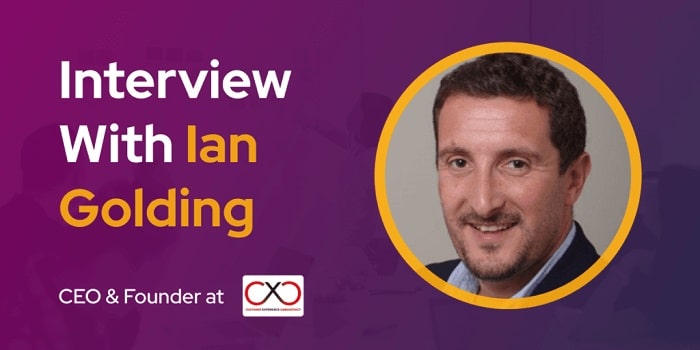Hi Ian, tell us about yourself and your background?
I have been involved in the field of customer experience and business improvement for over 25 years. Having spent 17 years working within a corporate environment across financial services, outsourcing, foodservice, and retail, I launched my own independent CX consultancy in February 2012. Over the last 9 years, I have worked in 44 countries around the world, across multiple industries. I consider myself to be hugely fortunate to have worked in so many different industries, organizations and scenarios, giving me a wonderful insight into the way CX is evolving globally. I am happily married with three wonderful children and our dog, Poppy!
What is the biggest misunderstanding about customer experience, in your opinion?
Interestingly, CX conceptually is really not difficult to understand. However, in my opinion, CX has become a science – behind that science are a number of competencies. The lack of understanding of what the competencies actually are and how to successfully apply them is striking. The need to enhance education around CX is very significant. CX does not happen by ‘osmoses’! CX is not ‘soft and fluffy’! It is a discipline that needs to be understood, committed to, and matured over time.
What are some of the newer CX companies/solutions you’re keeping your eyes on right now?
I am always interested in how industries are continually being disrupted by new companies entering their markets with a very different attitude to business. The most customer-centric companies in the world are the ones who differentiate themselves on the whole experience – NOT just their products and services. Disruptors are able to enter a market without any of the legacies that traditional businesses often have hanging around their necks – product & task focus; sales first mindset; overly complex processes; inadequate technology, etc.- The pandemic has increased the number of disruptors entering all markets and highlighted the lack of ability to adapt to traditional, legacy organizations.
What can companies do to improve customer loyalty and retention?
Organizations need to remind themselves of why they exist in the first place – their true purpose. Unfortunately, over time, many businesses have convinced themselves that the reason they exist is to make money. However, the real reason a business exists is to fulfill its purpose – the better able they are at fulfilling their purpose, the more money they will make. This is a subtle, but very significant distinction. If a company wants to improve loyalty and retention, it must more effectively balance the needs of the business with the needs of the customer. This means that they must always ‘think and act’ in the interests of the customer – by doing so, not only will they better meet the needs and expectations of customers, but they will also have a greater propensity to develop stronger, longer-lasting relationships with them.
What do you think is most relevant and why: CSAT (customer satisfaction score), NPS (net promoter score), or CES (customer effort score)?
CX measurement is where the real science of CX comes into play. When it comes to measuring the voice of the customer (VOC), many mechanisms exist. CSAT, NPS, and CES are the most commonly used but are not the only mechanisms that can be used. All three of them are extremely important ‘barometers’ of customer perception – they ALL have their relevance – no one metric is better than another. What is important is that a company should NEVER rely on one of these mechanisms alone. Unfortunately, too often, VOC metrics are not being applied in a way that provides a representative understanding of the end-to-end customer journey and all customers who come within it. This means that most organizations are drawing the working conclusion from the VOC measurement. I, therefore, believe that as many of these mechanisms should be measured as possible, enabling the most accurate representation of the truth to be gathered.
How can companies better use social media in the era of customer-centricity and personalization?
Social media has a critical role to play in the world of CX. As well as a vital marketing engine, social media is also a very important source of unsolicited customer feedback. Whilst organizations spend huge sums of money ‘pushing’ VOC surveys to customers, every day a plethora of unsolicited feedback is being left on social media platforms that should be providing a huge insight into the way customers are feeling about their experiences. It is so important that companies make better use of social media interaction in drawing an accurate conclusion of how their customers feel and what needs to be improved in the customer journey.
What is your opinion on AI-based chatbots to handle customer support?
My view on chatbots is the same as any form of new or evolving technology. If technology is adopted in alignment with the customer journey, then I believe that it will continue to improve companies’ ability to better meet the needs and expectations of their customers. However, too many are adopting technology to eliminate human interaction and save money. If the latter is the case, very often technology will make experiences worse for customers.
What was the best movie you saw that has come out during this past year?
In all honesty – I cannot remember! As a result of the pandemic, I have re-watched so many movies with my family, everything has merged into one!!! I am a huge fan of the movie ‘Yesterday’ based on the music of the Beatles!!
Last but not least, what is your favorite CX metric?
An interesting question – and I will answer in a way that you may not expect. Whilst most companies obsess with VOC metrics, I am a huge advocate of what I call VOP – voice of the process – metrics. Customer experience is all about ‘cause and effect’. VOC tells you the effect of what your organization is doing. VOP tells you what is causing the customer to feel the way they feel. I believe that having a measurable understanding of the relationship between VOP and VOC unlocks the real magic of CX improvement!






